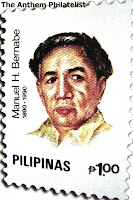Jose P. Laurel on Stamps

Jose P. Laurel (March 9, 1891 - November 6, 1959) was the third president of the Republic of the Philippines. An Associate Justice of the Supreme Court before becoming president, he was also an educator, having founded the Lyceum of the Philippines.
Laurel was born on 9 March 1891 in Tanauan, Batangas to Sotero Laurel and Jacoba Garcia. His father, who was the Secretary of the Interior in Emilio Aguinaldo's cabinet and a signatory to the Malolos Constitution, was taken prisoner during the Filipino-American War and died in captivity in 1902 when Laurel was only 11 years old.
This led the young Laurel to work as an altar boy and chorister, later taking on a job as a part-time laborer at the Bureau of Forestry when he turned 18, for the money he needed to continue his studies. He later became a clerk for the Code Committee, where he met Thomas Atkins Street, a future member of the Philippine Supreme Court and who served as his mentor.
After graduating from the Manila High School (now Araullo High School) in 1911, he eloped with Paciencia Hidalgo, and enrolled at the University of the Philippines College of Law, where he later earned his doctorate in Philosophy. He ranked second in his class of 60 and also came out second in the 1915 Bar Examinations.
Laurel later obtained a Licenciado en Jurisprudencia degree from the Escuela de Derecho in Manila while serving as Chief of the Executive Bureau's Administration Division. He was later sent to Yale University as a government pensionado in 1919, earning a degree in civil law a year later.
He also took special courses in international law at Oxford University in England and the University of Paris in France, before returning to the Philippines in 1921.
Upon his return to the country in 1921, Laurel was appointed chief of the Executive Bureau on the strength of his academic achievements. A year later, he was promoted to Undersecretary of the Interior, and after ten months was made Secretary of the same department by Governor-General Leonard Wood.
Laurel resigned his post along with the rest of the Filipino members of the Cabinet during the Cabinet Crisis of 1923. It was a sign of protest against Wood's opposition to measures working for Philippine independence by vetoing 16 bills passed by the Philippine Legislature.
After resigning from Wood's cabinet, Laurel opened a law office and taught law in Manila before running for a Senate seat in the 1924 elections. Winning in the elections, he however lost to Claro M. Recto in the 1931 elections. He was later elected as the delegate for Batangas in the 1934 Constitutional Convention. Laurel was considered one of the “Seven Wise Men” of the convention, heading the committee on the Bill of Rights.
Laurel was later appointed by Pres. Manuel L. Quezon as an Associate Justice of the Supreme Court in 1935, where he became famous for many landmark decisions, such as on the Nalundasan case in 1940, acquitting future president Ferdinand E. Marcos of murder after finding the prosecution's case contradictory.
Another landmark decision was on the Angara v. Electoral Commission case, where he affirmed the power of the judiciary to interpret the Constitution and to place under judicial review the actions of the other branches of government.
As World War II broke out in the Pacific on 8 December 1941, Quezon along with other government officials fled to Corregidor to establish a Commonwealth government in exile. However, Laurel was ordered to remain in Manila by Quezon because of his close relationship with Japanese officials (even receiving an honorary doctorate from Tokyo University) before the war broke out.
As the Japanese took over the Philippines in January 1942, they created the Philippine Executive Commission to govern the country. First headed by Jorge B. Vargas, former mayor of Manila, the commission included Laurel as Commissioner of Justice, and later Commissioner of the Interior. Because of this appointment, Laurel was seen as a collaborator with the Japanese.
On 5 June 1943, Laurel was shot while playing golf in Wack-Wack, but survived. He was then elected president of the Japanese-sponsored Republic on 25 September 1943, with Benigno Aquino, Sr. as speaker. They were then flown to Tokyo along with Vargas, where they were prodded by the Japanese government to declare war on the United States and Great Britain. Laurel refused, saying that the Filipinos would disapprove of it and he would lose his following if he did so.
Laurel nonetheless instituted a Filipino First policy. He had all Japanese guards and advisers removed from Malacañang, saying that if the Japanese were really sincere about independence they should prove it. He also asserted custody over Manuel Roxas to prevent him from falling into the hands of the Japanese.
However, as the Americans launched the first air raid on Manila and the Japanese threatened to kill more Filipinos if he did not agree, Laurel issued a declaration of war on the United States and Great Britain after consulting with Roxas and other Filipino leaders. There was one condition: no Filipino could be drafted into service under the Japanese military.
Despite this restriction, the pro-Japanese Makabayang Pilipino, or Makapili, was formed by Benigno Ramos, Pio Duran and Gen. Artemio Ricarte in December 1944. During its inauguration at the Legislative Building, Laurel delivered a speech that rebuked its formation.
As the war neared its end, the Japanese ordered Laurel and other government officials to leave for Baguio, from where they were brought to Japan as hostages. After Japan surrendered on 15 August 1945, Laurel dissolved the Japanese-sponsored Philippine Republic two days later.
He contacted General Douglas MacArthur on 14 September 1945 to inform him of his whereabouts. The next day, Laurel and his family were arrested and imprisoned in Japan by American agents. Without any writing instruments and the only reading material allowed him was a book called The World in 2030 AD given by his son, Salvador, Laurel started to write his War Memoirs during his imprisonment.
Laurel was flown back to Manila by the Americans on 23 July 1946 and was imprisoned in Muntinlupa to face trial for the crime of treasonable collaboration against the United States. Meanwhile, Roxas—whom he had sheltered during the war—was elected president of the Philippines.
Laurel appeared before the People's Court on 2 September 1946, pleading not guilty. His petition for bail was granted on 14 September 1946, and the trial was scheduled for July 1947. This was halted when Roxas issued a proclamation granting amnesty to all political and economic collaborators on 28 January 1947.
Laurel later ran for the presidency under the Nacionalista Party in the elections of 1949, but lost to Elpidio Quirino of the Liberal Party amid charges of massive cheating and fraud. Despite losing in the presidential race, Laurel won a Senate seat in 1951. During his Senate stint he authored many landmark bills, such as the Rizal bill, which made Jose Rizal's two novels, (Noli Me Tangere and El Filibusterismo) compulsory reading in all universities and colleges. He and Claro M. Recto also authored the bill that established the National Education Board.
He also called for the creation of an economic superbody to formulate and implement the economic and monetary policies of the government, which would later become the forerunner of the present National Economic Development Authority (NEDA). After retiring from politics, Laurel focused on managing the Lyceum of the Philippines, which he founded on 7 July 1952. During that time, he also served as the president of the Philippine Banking Corporation.
He died on 6 November 1959 of a massive heart attack and stroke.
Date of Issue: June 3, 1991






